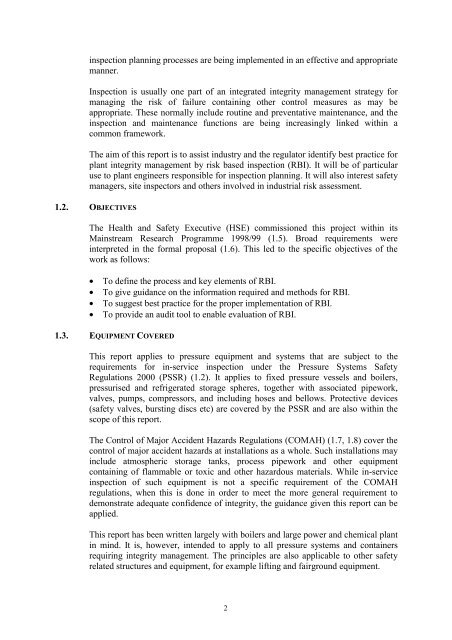Best Practice for Risk Based Inspection
risk based inspection
risk based inspection
You also want an ePaper? Increase the reach of your titles
YUMPU automatically turns print PDFs into web optimized ePapers that Google loves.
inspection planning processes are being implemented in an effective and appropriate<br />
manner.<br />
<strong>Inspection</strong> is usually one part of an integrated integrity management strategy <strong>for</strong><br />
managing the risk of failure containing other control measures as may be<br />
appropriate. These normally include routine and preventative maintenance, and the<br />
inspection and maintenance functions are being increasingly linked within a<br />
common framework.<br />
The aim of this report is to assist industry and the regulator identify best practice <strong>for</strong><br />
plant integrity management by risk based inspection (RBI). It will be of particular<br />
use to plant engineers responsible <strong>for</strong> inspection planning. It will also interest safety<br />
managers, site inspectors and others involved in industrial risk assessment.<br />
1.2. OBJECTIVES<br />
The Health and Safety Executive (HSE) commissioned this project within its<br />
Mainstream Research Programme 1998/99 (1.5). Broad requirements were<br />
interpreted in the <strong>for</strong>mal proposal (1.6). This led to the specific objectives of the<br />
work as follows:<br />
• To define the process and key elements of RBI.<br />
• To give guidance on the in<strong>for</strong>mation required and methods <strong>for</strong> RBI.<br />
• To suggest best practice <strong>for</strong> the proper implementation of RBI.<br />
• To provide an audit tool to enable evaluation of RBI.<br />
1.3. EQUIPMENT COVERED<br />
This report applies to pressure equipment and systems that are subject to the<br />
requirements <strong>for</strong> in-service inspection under the Pressure Systems Safety<br />
Regulations 2000 (PSSR) (1.2). It applies to fixed pressure vessels and boilers,<br />
pressurised and refrigerated storage spheres, together with associated pipework,<br />
valves, pumps, compressors, and including hoses and bellows. Protective devices<br />
(safety valves, bursting discs etc) are covered by the PSSR and are also within the<br />
scope of this report.<br />
The Control of Major Accident Hazards Regulations (COMAH) (1.7, 1.8) cover the<br />
control of major accident hazards at installations as a whole. Such installations may<br />
include atmospheric storage tanks, process pipework and other equipment<br />
containing of flammable or toxic and other hazardous materials. While in-service<br />
inspection of such equipment is not a specific requirement of the COMAH<br />
regulations, when this is done in order to meet the more general requirement to<br />
demonstrate adequate confidence of integrity, the guidance given this report can be<br />
applied.<br />
This report has been written largely with boilers and large power and chemical plant<br />
in mind. It is, however, intended to apply to all pressure systems and containers<br />
requiring integrity management. The principles are also applicable to other safety<br />
related structures and equipment, <strong>for</strong> example lifting and fairground equipment.<br />
2



